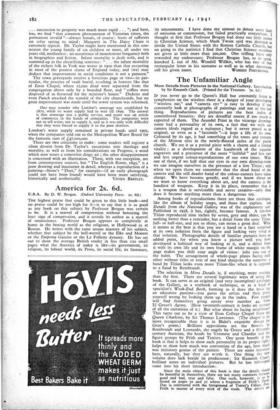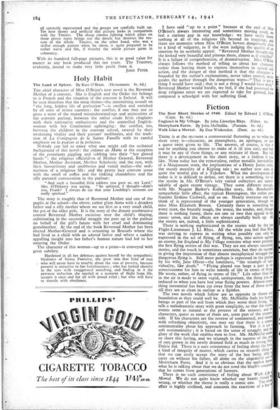The Unfamiliar Angle
More Details from Pictures in the National Gallery. Introduction by Sir Kenneth Clark. (Printed for the Trustees. 75. 6d.)
IF you never go to the Queen's Hall but constantly listen to symphonies on the wireless there is a danger of your developing " wireless ear," and " camera eye " is easy to develop if you constantly look at photographs of paintings and not at the real thing. Reproductions of pictures are the best index of remembered beauties : they are dreadful snares if too much is expected of them. The Arundel Print in the vicarage drawing- room had a personality of its own, a fact that we with our camera ideals regard as a nuisance ; but it never posed as an original, or even as a "facsimile "—it kept a life of its own. Coloured by its age, it had something of the tones and textures of the Minton tiles in the newly-floored aisles of the parish church. We see it as a period piece with a charm and a limited vitality ; as a development of the handwork of the aquatint engravers and a precursor of the more " faithful " and less rare and less urgent colour-reproductions of our own times. With one of these, if we half shut our eyes in our own drawing-room we can imagine ourselves in the presence of a live Titian ; only when we open them we remember that the dead hand of the camera and the still deader hand of the colour-camera have taken charge. We have become greedy, and if we know about art we want to know everything about art, and the camera is the handiest of weapons. Keep it in its place, remember that it is a weapon that is serviceable and never creative—only then does it become anything more than a dangerous toy.
Among books of reproductions there are those that catalogue, like the album of holiday snaps, and those that explain. too Details from the Natioiud Gallery was of the explanatory sort. Published in 1938, it has, rightly, become famous. A ten-foot Titian reproduced nine inches by seven, grey and shiny, can be nothing better than a reminder, but a detail from the same Titian, full- or half-size, and not so shiny, can mean a great deal. What it means at the best is that you see a hand or a face surprised at its own isolation from the figure and looking very vivid in that isolation. Photographic details of familiar pictures have an added point, for when you know a picture well you have developed a habitual way of looking at it, and a detail from it with its own life and its own frame of white margin on the page makes you shift your angle of vision : jolts you out of the habit. The arrangement of whole-page plates facing each other without titles or text of any kind sharpens the surprise: a hand by Titian looks even more Titian-like when it is opposed to a band by Rembrandt.
The selection in More Details is, if anything, more exciting than the first. There are several 'legitimate ways of using the book. It can serve as an original (and very incomplete) catalogue of the Gallery, as a textbook of technique, or as a kind of specialist's Week-End Book, forming as it does the basis for an educative pastime—you guess the artists and then prove yourself wrong by looking them up in the index. Few people will find themselves going astray over number 44, from El Greco's Agony. (How twentieth-century it looks on account of all the imitations of it.) But what about its facing neighbour? This turns out to be a view of Eton College Chapel from the Queen Charlotte, by Sir Thomas Lawrence. (The chapel is far more recognisable than it is in Blake's exquisite design for Gray's poem.) Brilliant appositions are the flowers h% Rembrandt and Leonardo, the angels by Greco and a fifteenth- century Austrian, the heads by Veronese and Chardin and the figure groups by Frith and Tethers. One great benefit of the book is that it helps to show each personality in its proper light ; helps to show how much was convention of the age, how mud' was initiatory genius of the painter. There are some injustices here, naturally, but they are worth it. One thing the new volume does lack beside its predecessor: Sir Kenneth Clark's brilliant notes on individual pictures. But he has telescoped some into his short introduction: Since the main object of this book is that the details should be beautiful in themselves, there are not many contrasts between, good and bad, true and false. One such, however, is 10 o' found on pages 3o and 31 where a fragment of Frith's Deb' Day is contrasted with the foreground of Tenier's Village Fete. Frith is master of every trick of the trade. The details are all correctly represented and the groups are carefully built up. Yet how showy and artificial this picture looks in comparison with the Teniers. The sharp cinema lighting which plays on those glossy types brings out the details but destroys the tex- ture of the whole. Teniers, on the other hand, who was a skilful enough painter when he chose, is quite .prepared .to be rather naive and flat, if thereby the whole picture gains in coherency.
With its hundred full-page pictures, this is as good value for money as any book produced this ten years. The Trustees, evidently, intend to make very little profit from it.
JOHN PIPER.































 Previous page
Previous page